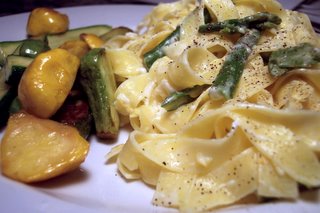 My predilection for consuming babies is well-documented, of course. So how could I resist this Paper Chef challenge? The ingredients: Quinoa, Yogurt, Cashews, and Baby Food. My final menu: Baby Curry and Quinoa Fritters with Cashew Cream.
My predilection for consuming babies is well-documented, of course. So how could I resist this Paper Chef challenge? The ingredients: Quinoa, Yogurt, Cashews, and Baby Food. My final menu: Baby Curry and Quinoa Fritters with Cashew Cream.
The rundown: The curry contains baby sheep, baby spinach, Yobaby yogurt (double word score!), and actual baby food. The fritters were my first encounter with quinoa--an ingredient I've previously shunned as fodder fit only for unwashed hippies--they contain eggs, which could have been baby chickens. The curry was served with a side of baby banana. And the cashew cream, while it involves no babies, is one of the neatest science experiments I've ever done in the kitchen.
My only regret: The final plate wasn't terrible photogenic. But the Human Vacuum and our dinner guest will vouch for its tastiness. They also made an interesting observation: Apparently, contra Eddie Izzard, baby doesn't taste like chicken after all.
***
Baby Curry (or, if you're squeamish, Spicy Baby Sheep, Baby Spinach, and Butternut Squash Baby Food Curry)
Cut into large chunks:
3-4 pound butterflied leg of lamb, or other lamb stew meat
Combine, and set aside:
4 cloves garlic, finely minced or microplaned
1 inch piece fresh ginger, peeled and finely minced
2 heaping Tablespoons garam masala
2 teaspoons cumin
3-4 small green chile peppers, minced
Heat, on medium high, in a large, heavy-bottomed pan:
3 Tablespoons oil
Slice into the pan, and fry until soft:
1 large onion
Increase the heat to high and add the mixture of spices and:
3 Tablespoons tomato paste
2 Tablespoons butternut squash baby food
Fry for 2-3 minutes, until tomato starts to caramelize. Add the lamb chunks and brown on all sides. With the heat still on high, add:
One tub Yobaby yogurt
Add the yogurt one tablespoon at a time, and cook until each dose of yogurt is absorbed before adding the next spoonful. This tenderizes the lamb and will later thicken the sauce. When all the yogurt is cooked in, pour enough water to cover the lamb. Bring to a boil, then reduce to a low simmer and cover. Simmer for about 1 hour.
While the lamb cooks, make the quinoa fritters (below).
When the lamb is almost done, blanch in boiling water (for > 1 minute):
8 handfuls baby spinach
1 handful fresh cilantro, stems removed
Add the spinach, salt and pepper to taste, and cook for 15 more minutes.
***
Curried Quinoa Fritters
 Heat a dry saucepan on high, add:
Heat a dry saucepan on high, add:
2/3 cup quinoa, rinsed and dried
Toast the grains, stirring constantly to prevent scorching, for 5 minutes. Then add:
1 1/3 cups water
Bring to a boil and then cover and reduce heat to low. Simmer for 10-15 minutes, until all water is absorbed. Remove from heat and let cool.
While the quinoa cools, make the cashew cream (below).
When the quinoa is cool, add and blend thoroughly until soft and squishy:
1/4 cup flour
1/4 cup grated cheese (Use something like smoked gouda)
3/4 teaspoon salt
1-2 Tablespoons hot curry powder
4 scallions, minced
1 handful fresh cilantro, minced
1 large egg
2 egg yolks (for a total of 3 unborn chickens!)
Heat in a large skillet, on high heat:
3/4 cup oil (I used peanut oil)
I'd never made fritters before (though I am expert at frittering away time), but I found that this was the easiest way to form the fritters: Put 2-3 tablespoons of dough in the palm of your hand, then close your fist and squish the mixture together. Imagine that you have one of those gel-filled stress balls. You'll feel the dough solidify. Drop each fritter into the hot oil, and fry about 45 seconds on each side. Remove to a paper-towel covered plate to absorb excess oil. When you've made the whole batch, transfer to an attractive plate and stash in a low oven to keep 'em warm while you finish the curry.
***
Cashew Cream
I picked up this recipe at a cooking seminar at the Four Seasons in Washington. The original use was to replace cream as a drizzle on a thick soup. It's absurdly easy: All you have to do is run the blender for a minute or two on high and, while you watch, some kind of kitchen alchemy will happen. A bunch of nuts become a lovely, warmly-spiced delight. If only I could perform some kind of similar magic on my friends.
In a high-speed blender, combine:
1/2 cup raw cashews
3 Tablespoons water
3 Tablespoon brandy or sherry
A few gratings of nutmeg
1/4 teaspoon cinnamon
Theoretically, this might be a "healthier" alternative to cream or coconut milk. Not that I care.
***
To serve:
Scatter some cilantro on top of the dish of fritters. Serve the curry hot, alongside a bowl of basmati rice. Drizzle the cashew cream on the curry, or use it as a dippin' sauce for the fritters. Slice a baby banana onto each person's plate. Enjoy!

Tagged with: Paper Chef

.jpg)


























